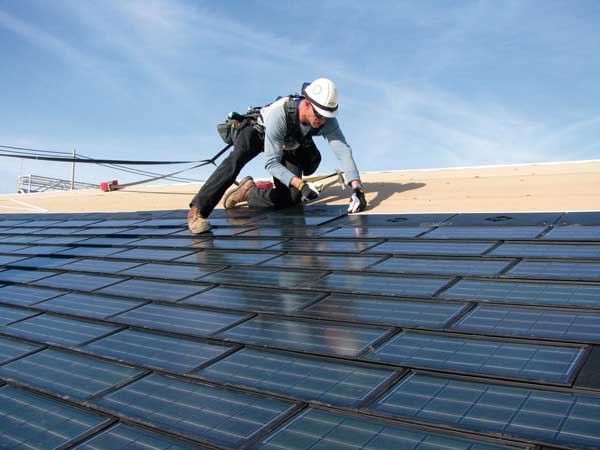Cleveland Roofing Specialists Offering High-Quality Roof Repair and Installation Services
A Comprehensive Overview to Effective Roof Covering Apartment Roofing Setup
The details of flat roof setup demand a thorough method, starting with a detailed understanding of various level roof kinds and the important materials needed for optimum performance. An effective installation pivots not only on the option of products but additionally on the preparation and execution of each action involved in the procedure.
Understanding Flat Roof Covering Types
When taking into consideration flat roofing systems, it is vital to understand the different kinds readily available, as each offers distinct advantages and downsides customized to details needs. One of the most usual kinds of level roofing systems consist of Built-Up Roofing (BUR), Customized Bitumen, and Single-Ply membrane layers.
Built-Up Roof includes several layers of asphalt and crushed rock, offering excellent toughness and climate resistance. It is especially useful in locations susceptible to serious weather yet might need even more maintenance because of its complicated building.
Modified Bitumen is a popular choice for its convenience of installment and adaptability. It usually uses a torch-applied or self-adhesive approach, which can be helpful for quick repair work and long-term efficiency. Nonetheless, its life-span can be shorter compared to BUR.
Single-Ply membranes, including Thermoplastic Olefin (TPO) and Ethylene Propylene Diene Monomer (EPDM), are recognized for their light-weight nature and energy efficiency. These products are usually liked for industrial buildings as a result of their cost-effectiveness and simplicity of installation (Cleveland Roofing Specialists). However, they may not supply the exact same degree of insulation as various other options.
Each roofing type requires careful consideration based on environment, budget plan, and particular task demands.
Vital Materials for Flat Roofing
A variety of necessary materials are critical for the successful installment of flat roof covering systems. The option of products directly influences toughness, performance, and general effectiveness.
Among the key materials is the roof covering membrane, which can be built from numerous substances such as thermoplastic polyolefin (TPO), ethylene propylene diene monomer (EPDM), or PVC. Each kind offers special benefits, including UV resistance and adaptability, which are vital for extended efficiency.
Along with the membrane, insulation materials play a substantial role in energy effectiveness. Inflexible foam boards or polyisocyanurate insulation are popular options, as they supply excellent thermal resistance and moisture administration.
In addition, roofing adhesives and sealants are necessary for making certain a watertight setup. These items need to work with the picked membrane to prevent wear and tear in time.
Preparing for Installment
Correct preparation is necessary for a successful flat roof installment, as it lays the foundation for a efficient and durable roofing system. Begin by performing a detailed assessment of the existing roofing structure.
Following, collect all required tools and products, guaranteeing that they meet sector requirements. This includes water-proof membrane layers, insulation, flashing, and bolts. Familiarize on your own with the maker's specs, as adherence to these standards is vital for guarantee purposes.
Take into consideration weather conditions; prevent installment during heavy rain or extreme temperature levels, which can influence product efficiency. By taking these preparatory steps, you can enhance the probability of an effective level roof covering installation that meets both aesthetic and structural demands.
Step-by-Step Setup Refine
With the foundation established through comprehensive preparation, the next stage includes carrying out the flat roof installment methodically. This step is essential for maintaining the roof's stability over time.
Complying with the vapor barrier installation, lay down insulation boards, guaranteeing they fit tightly together to lessen thermal bridging. Safeguard the insulation with suitable bolts based on the roofing system kind and regional structure codes - Cleveland Roofing Specialists.
Guarantee correct overlap at edges and seams to develop a leak-proof seal. Make use of adhesives, mechanical fasteners, or warmth welding as needed. Ultimately, install flashing around borders, vents, and any roofing penetrations to improve waterproofing. After setup, perform an extensive examination to identify any type of possible issues before wrapping up the task, ensuring a dependable and robust level roof covering system.
Maintenance Tips for Longevity
Regular maintenance is necessary to make certain the longevity and efficiency of a level roof. Among the primary tasks is to carry out regular evaluations at the very least two times a year, preferably in springtime and autumn. During these evaluations, search for indications of wear, such as blisters, cracks, or merging water, which can show underlying problems.

Making certain proper drain is crucial to stop water buildup. Check and clear gutters, downspouts, and scuppers to ensure unhampered water circulation. Additionally, examine seals around vents, skylights, and various other infiltrations for any click here now kind of signs of wear and tear, applying caulk or sealer as required to keep a water tight obstacle.
Last but not least, consider professional maintenance services every few years for complete examinations and repairs. By adhering to these maintenance tips, you can considerably prolong the life of your flat roofing system, ensuring it stays a trustworthy guard versus the aspects.
Conclusion
Effective flat roofing system installation requires a systematic strategy incorporating comprehensive examinations, product option, and thorough preparation. Sticking to the outlined actions throughout the setup process guarantees the proper application of roof covering membrane layers and insulation while improving waterproofing via efficient flashing installment. Applying routine maintenance techniques substantially contributes to the long life of the roof system. By following these standards, a long lasting and reputable level roofing remedy can be accomplished, qualified of standing up to various ecological conditions.
The ins and outs of flat roofing system installment need a meticulous method, starting with a comprehensive understanding of different level roof covering types and the necessary products required for ideal efficiency.Correct preparation is vital for an effective level roof setup, as it lays the groundwork for a go to these guys sturdy and effective roof covering system. After installment, perform an extensive assessment to recognize any kind of potential issues before concluding the job, making sure a durable and trusted flat roof system.
